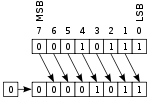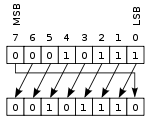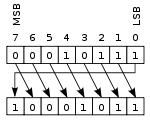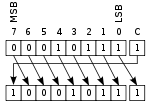|
Bitwise operation
In computer programming, a bitwise operation operates on a bit string, a bit array or a binary numeral (considered as a bit string) at the level of its individual bits. It is a fast and simple action, basic to the higher-level arithmetic operations and directly supported by the processor. Most bitwise operations are presented as two-operand instructions where the result replaces one of the input operands. On simple low-cost processors, typically, bitwise operations are substantially faster than division, several times faster than multiplication, and sometimes significantly faster than addition. While modern processors usually perform addition and multiplication just as fast as bitwise operations due to their longer instruction pipelines and other architectural design choices, bitwise operations do commonly use less power because of the reduced use of resources.[1] Bitwise operatorsIn the explanations below, any indication of a bit's position is counted from the right (least significant) side, advancing left. For example, the binary value 0001 (decimal 1) has zeroes at every position but the first (i.e., the rightmost) one. NOTThe bitwise NOT, or bitwise complement, is a unary operation that performs logical negation on each bit, forming the ones' complement of the given binary value. Bits that are 0 become 1, and those that are 1 become 0. For example: NOT 0111 (decimal 7) = 1000 (decimal 8) NOT 10101011 (decimal 171) = 01010100 (decimal 84) The result is equal to the two's complement of the value minus one. If two's complement arithmetic is used, then For unsigned integers, the bitwise complement of a number is the "mirror reflection" of the number across the half-way point of the unsigned integer's range. For example, for 8-bit unsigned integers, AND A bitwise AND is a binary operation that takes two equal-length binary representations and performs the logical AND operation on each pair of the corresponding bits. Thus, if both bits in the compared position are 1, the bit in the resulting binary representation is 1 (1 × 1 = 1); otherwise, the result is 0 (1 × 0 = 0 and 0 × 0 = 0). For example: 0101 (decimal 5) AND 0011 (decimal 3) = 0001 (decimal 1) The operation may be used to determine whether a particular bit is set (1) or cleared (0). For example, given a bit pattern 0011 (decimal 3), to determine whether the second bit is set we use a bitwise AND with a bit pattern containing 1 only in the second bit: 0011 (decimal 3) AND 0010 (decimal 2) = 0010 (decimal 2) Because the result 0010 is non-zero, we know the second bit in the original pattern was set. This is often called bit masking. (By analogy, the use of masking tape covers, or masks, portions that should not be altered or portions that are not of interest. In this case, the 0 values mask the bits that are not of interest.) The bitwise AND may be used to clear selected bits (or flags) of a register in which each bit represents an individual Boolean state. This technique is an efficient way to store a number of Boolean values using as little memory as possible. For example, 0110 (decimal 6) can be considered a set of four flags numbered from right to left, where the first and fourth flags are clear (0), and the second and third flags are set (1). The third flag may be cleared by using a bitwise AND with the pattern that has a zero only in the third bit: 0110 (decimal 6) AND 1011 (decimal 11) = 0010 (decimal 2) Because of this property, it becomes easy to check the parity of a binary number by checking the value of the lowest valued bit. Using the example above: 0110 (decimal 6) AND 0001 (decimal 1) = 0000 (decimal 0) Because 6 AND 1 is zero, 6 is divisible by two and therefore even. OR A bitwise OR is a binary operation that takes two bit patterns of equal length and performs the logical inclusive OR operation on each pair of corresponding bits. The result in each position is 0 if both bits are 0, while otherwise the result is 1. For example: 0101 (decimal 5) OR 0011 (decimal 3) = 0111 (decimal 7) The bitwise OR may be used to set to 1 the selected bits of the register described above. For example, the fourth bit of 0010 (decimal 2) may be set by performing a bitwise OR with the pattern with only the fourth bit set: 0010 (decimal 2) OR 1000 (decimal 8) = 1010 (decimal 10) XOR A bitwise XOR is a binary operation that takes two bit patterns of equal length and performs the logical exclusive OR operation on each pair of corresponding bits. The result in each position is 1 if only one of the bits is 1, but will be 0 if both are 0 or both are 1. In this we perform the comparison of two bits, being 1 if the two bits are different, and 0 if they are the same. For example: 0101 (decimal 5) XOR 0011 (decimal 3) = 0110 (decimal 6) The bitwise XOR may be used to invert selected bits in a register (also called toggle or flip). Any bit may be toggled by XORing it with 1. For example, given the bit pattern 0010 (decimal 2) the second and fourth bits may be toggled by a bitwise XOR with a bit pattern containing 1 in the second and fourth positions: 0010 (decimal 2) XOR 1010 (decimal 10) = 1000 (decimal 8) This technique may be used to manipulate bit patterns representing sets of Boolean states. Assembly language programmers and optimizing compilers sometimes use XOR as a short-cut to setting the value of a register to zero. Performing XOR on a value against itself always yields zero, and on many architectures this operation requires fewer clock cycles and less memory than loading a zero value and saving it to the register. If the set of bit strings of fixed length n (i.e. machine words) is thought of as an n-dimensional vector space over the field , then vector addition corresponds to the bitwise XOR. Mathematical equivalentsAssuming , for the non-negative integers, the bitwise operations can be written as follows: Truth table for all binary logical operatorsThere are 16 possible truth functions of two binary variables; this defines a truth table. Here is the bitwise equivalent operations of two bits P and Q:
Bit shiftsThe bit shifts are sometimes considered bitwise operations, because they treat a value as a series of bits rather than as a numerical quantity. In these operations, the digits are moved, or shifted, to the left or right. Registers in a computer processor have a fixed width, so some bits will be "shifted out" of the register at one end, while the same number of bits are "shifted in" from the other end; the differences between bit shift operators lie in how they determine the values of the shifted-in bits. Bit addressingIf the width of the register (frequently 32 or even 64) is larger than the number of bits (usually 8) of the smallest addressable unit, frequently called byte, the shift operations induce an addressing scheme from the bytes to the bits. Thereby the orientations "left" and "right" are taken from the standard writing of numbers in a place-value notation, such that a left shift increases and a right shift decreases the value of the number ― if the left digits are read first, this makes up a big-endian orientation. Disregarding the boundary effects at both ends of the register, arithmetic and logical shift operations behave the same, and a shift by 8 bit positions transports the bit pattern by 1 byte position in the following way:
Arithmetic shift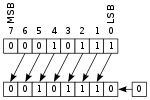 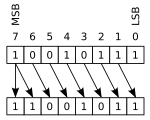 In an arithmetic shift, the bits that are shifted out of either end are discarded. In a left arithmetic shift, zeros are shifted in on the right; in a right arithmetic shift, the sign bit (the MSB in two's complement) is shifted in on the left, thus preserving the sign of the operand. This example uses an 8-bit register, interpreted as two's complement: 00010111 (decimal +23) LEFT-SHIFT = 00101110 (decimal +46) 10010111 (decimal −105) RIGHT-SHIFT = 11001011 (decimal −53) In the first case, the leftmost digit was shifted past the end of the register, and a new 0 was shifted into the rightmost position. In the second case, the rightmost 1 was shifted out (perhaps into the carry flag), and a new 1 was copied into the leftmost position, preserving the sign of the number. Multiple shifts are sometimes shortened to a single shift by some number of digits. For example: 00010111 (decimal +23) LEFT-SHIFT-BY-TWO = 01011100 (decimal +92) A left arithmetic shift by n is equivalent to multiplying by 2n (provided the value does not overflow), while a right arithmetic shift by n of a two's complement value is equivalent to taking the floor of division by 2n. If the binary number is treated as ones' complement, then the same right-shift operation results in division by 2n and rounding toward zero. Logical shift
In a logical shift, zeros are shifted in to replace the discarded bits. Therefore, the logical and arithmetic left-shifts are exactly the same. However, as the logical right-shift inserts value 0 bits into the most significant bit, instead of copying the sign bit, it is ideal for unsigned binary numbers, while the arithmetic right-shift is ideal for signed two's complement binary numbers. Circular shiftAnother form of shift is the circular shift, bitwise rotation or bit rotation. Rotate
In this operation, sometimes called rotate no carry, the bits are "rotated" as if the left and right ends of the register were joined. The value that is shifted into the right during a left-shift is whatever value was shifted out on the left, and vice versa for a right-shift operation. This is useful if it is necessary to retain all the existing bits, and is frequently used in digital cryptography.[clarification needed] Rotate through carry
Rotate through carry is a variant of the rotate operation, where the bit that is shifted in (on either end) is the old value of the carry flag, and the bit that is shifted out (on the other end) becomes the new value of the carry flag. A single rotate through carry can simulate a logical or arithmetic shift of one position by setting up the carry flag beforehand. For example, if the carry flag contains 0, then Rotate through carry is especially useful when performing shifts on numbers larger than the processor's native word size, because if a large number is stored in two registers, the bit that is shifted off one end of the first register must come in at the other end of the second. With rotate-through-carry, that bit is "saved" in the carry flag during the first shift, ready to shift in during the second shift without any extra preparation. In high-level languagesIn C family of languages
In C and C++ languages, the logical shift operators are " x = y << 2;
assigns Shifts can result in implementation-defined behavior or undefined behavior, so care must be taken when using them. The result of shifting by a bit count greater than or equal to the word's size is undefined behavior in C and C++.[2][3] Right-shifting a negative value is implementation-defined and not recommended by good coding practice;[4] the result of left-shifting a signed value is undefined if the result cannot be represented in the result type.[2] In C#, the right-shift is an arithmetic shift when the first operand is an int or long. If the first operand is of type uint or ulong, the right-shift is a logical shift.[5] Circular shifts
The C-family of languages lack a rotate operator (although C++20 provides uint32_t x = ..., n = ...;
uint32_t y = (x << n) | (x >> (32 - n));
However, a shift by uint32_t x = ..., n = ...;
uint32_t y = n ? (x << n) | (x >> (32 - n)) : x;
where the shift amount is tested to ensure that it does not introduce undefined behavior. However, the branch adds an additional code path and presents an opportunity for timing analysis and attack, which is often not acceptable in high-integrity software.[6] In addition, the code compiles to multiple machine instructions, which is often less efficient than the processor's native instruction. To avoid the undefined behavior and branches under GCC and Clang, the following is recommended. The pattern is recognized by many compilers, and the compiler will emit a single rotate instruction:[7][8][9] uint32_t x = ..., n = ...;
uint32_t y = (x << n) | (x >> (-n & 31));
There are also compiler-specific intrinsics implementing circular shifts, like _rotl8, _rotl16, _rotr8, _rotr16 in Microsoft Visual C++. Clang provides some rotate intrinsics for Microsoft compatibility that suffers the problems above.[9] GCC does not offer rotate intrinsics. Intel also provides x86 intrinsics. Java
In Java, all integer types are signed, so the " More details of Java shift operators:[10]
JavaScriptJavaScript uses bitwise operations to evaluate each of two or more units place to 1 or 0.[12] Pascal
In Pascal, as well as in all its dialects (such as Object Pascal and Standard Pascal), the logical left and right shift operators are " x := y shl 2;
Other
ApplicationsBitwise operations are necessary particularly in lower-level programming such as device drivers, low-level graphics, communications protocol packet assembly, and decoding. Although machines often have efficient built-in instructions for performing arithmetic and logical operations, all these operations can be performed by combining the bitwise operators and zero-testing in various ways.[13] For example, here is a pseudocode implementation of ancient Egyptian multiplication showing how to multiply two arbitrary integers c ← 0
while b ≠ 0
if (b and 1) ≠ 0
c ← c + a
left shift a by 1
right shift b by 1
return c
Another example is a pseudocode implementation of addition, showing how to calculate a sum of two integers while a ≠ 0
c ← b and a
b ← b xor a
left shift c by 1
a ← c
return b
Boolean algebraSometimes it is useful to simplify complex expressions made up of bitwise operations, for example when writing compilers. The goal of a compiler is to translate a high-level programming language into the most efficient machine code possible. Boolean algebra is used to simplify complex bitwise expressions. AND
OR
NOT
XOR
Additionally, XOR can be composed using the 3 basic operations (AND, OR, NOT)
Others
Inverses and solving equationsIt can be hard to solve for variables in Boolean algebra, because unlike regular algebra, several operations do not have inverses. Operations without inverses lose some of the original data bits when they are performed, and it is not possible to recover this missing information.
Order of operationsOperations at the top of this list are executed first. See the main article for a more complete list. See alsoReferences
External links
|
||||||||||||||||||||||||||||||||||||||||||||||||||||||||||||||||||||||||||||||||||||||||||||||||||||||||||||||||||||||||||||||||



![{\displaystyle {\begin{aligned}\operatorname {NOT} x&=\sum _{n=0}^{\lfloor \log _{2}(x)\rfloor }2^{n}\left[\left(\left\lfloor {\frac {x}{2^{n}}}\right\rfloor {\bmod {2}}+1\right){\bmod {2}}\right]=2^{\left\lfloor \log _{2}(x)\right\rfloor +1}-1-x\\x\operatorname {AND} y&=\sum _{n=0}^{\lfloor \log _{2}(x)\rfloor }2^{n}\left(\left\lfloor {\frac {x}{2^{n}}}\right\rfloor {\bmod {2}}\right)\left(\left\lfloor {\frac {y}{2^{n}}}\right\rfloor {\bmod {2}}\right)\\x\operatorname {OR} y&=\sum _{n=0}^{\lfloor \log _{2}(x)\rfloor }2^{n}\left(\left(\left\lfloor {\frac {x}{2^{n}}}\right\rfloor {\bmod {2}}\right)+\left(\left\lfloor {\frac {y}{2^{n}}}\right\rfloor {\bmod {2}}\right)-\left(\left\lfloor {\frac {x}{2^{n}}}\right\rfloor {\bmod {2}}\right)\left(\left\lfloor {\frac {y}{2^{n}}}\right\rfloor {\bmod {2}}\right)\right)\\x\operatorname {XOR} y&=\sum _{n=0}^{\lfloor \log _{2}(x)\rfloor }2^{n}\left(\left[\left(\left\lfloor {\frac {x}{2^{n}}}\right\rfloor {\bmod {2}}\right)+\left(\left\lfloor {\frac {y}{2^{n}}}\right\rfloor {\bmod {2}}\right)\right]{\bmod {2}}\right)=\sum _{n=0}^{\lfloor \log _{2}(x)\rfloor }2^{n}\left[\left(\left\lfloor {\frac {x}{2^{n}}}\right\rfloor +\left\lfloor {\frac {y}{2^{n}}}\right\rfloor \right){\bmod {2}}\right]\end{aligned}}}](https://wikimedia.org/api/rest_v1/media/math/render/svg/b873908a8c81ef7d63805b77756dbcf70a03b39c)
